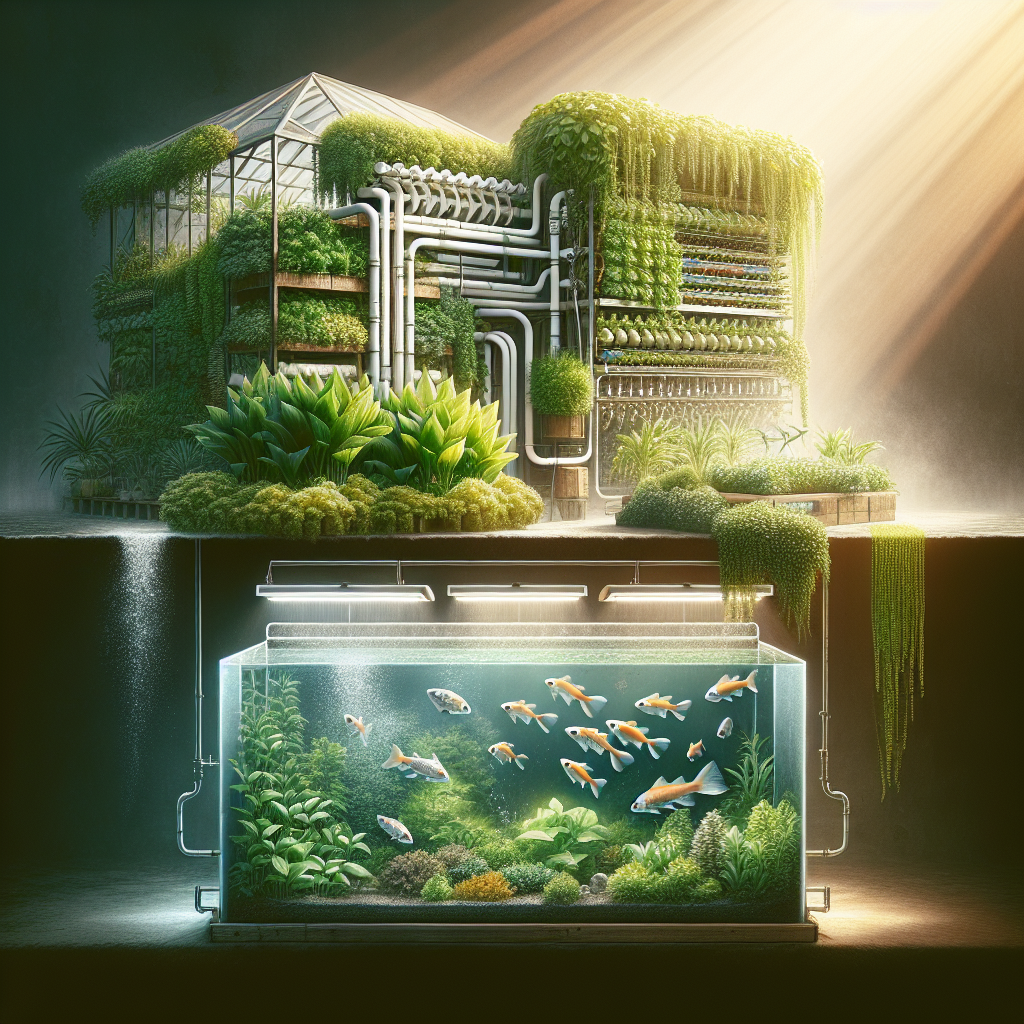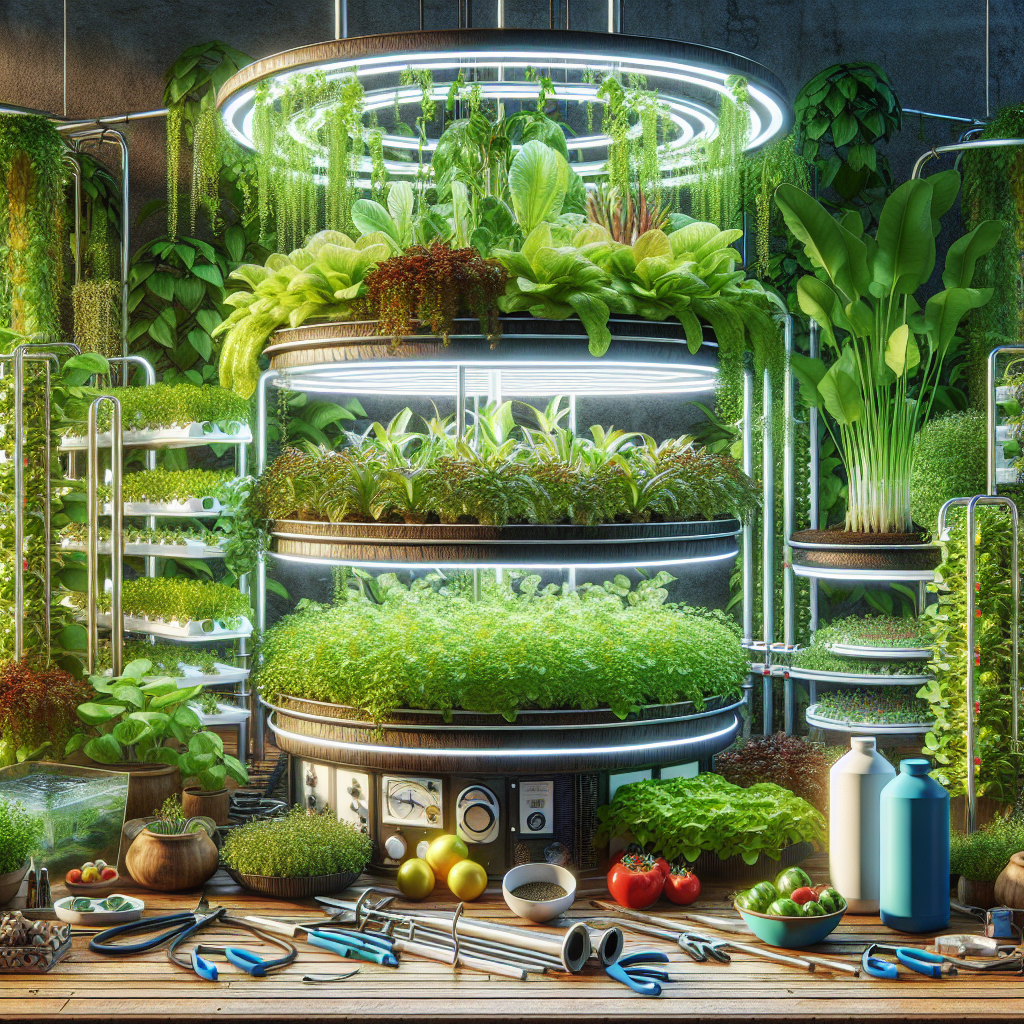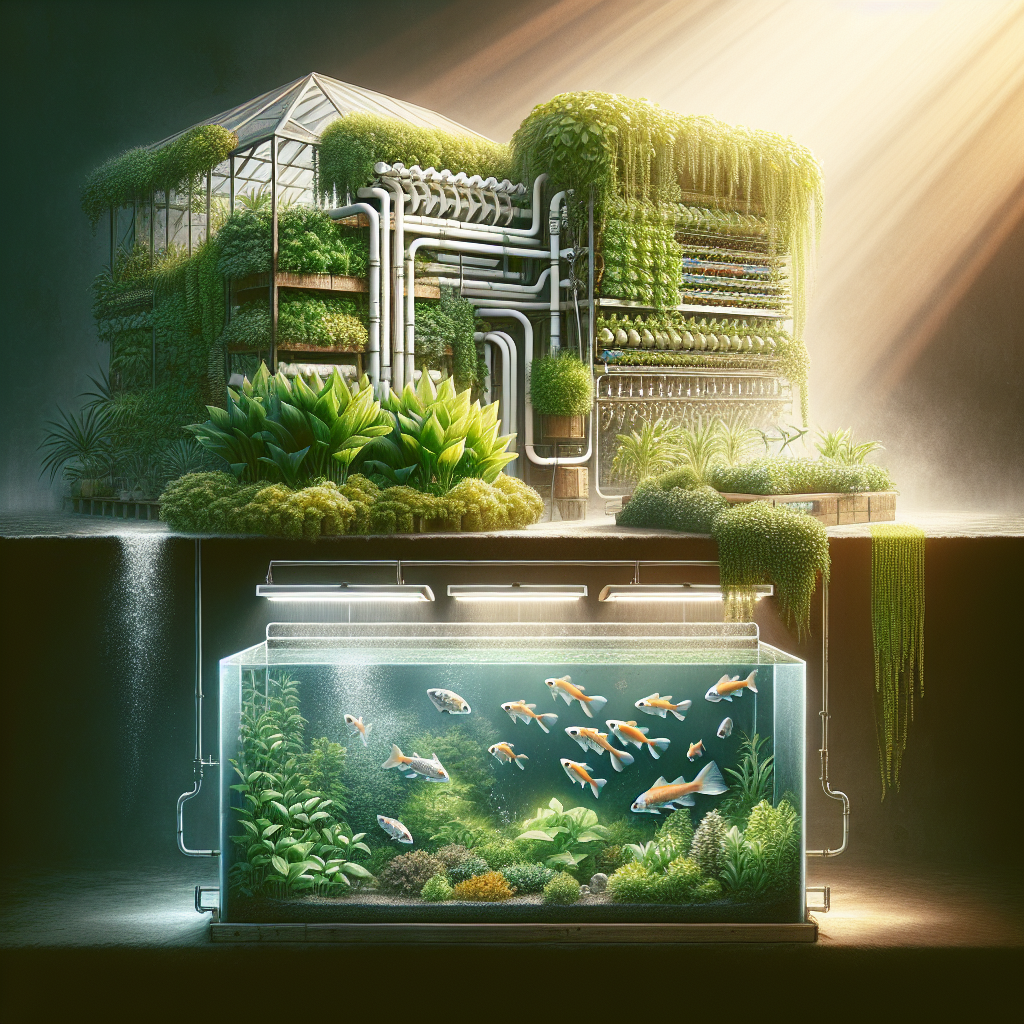Interested in starting your own aquaponics or hydroponics system but not sure where to begin? Look no further! This article will guide you through the process of getting started with these innovative gardening methods. Whether you’re interested in the symbiotic relationship between fish and plants in aquaponics or the soil-less cultivation of hydroponics, we’ve got you covered. And if you’re wondering about the frequency of changing the hydroponic solution, don’t worry, we’ll answer that for you too. So let’s dive in and explore how you can embark on your journey to sustainable and efficient gardening!

This image is property of images.unsplash.com.
Choosing Between Aquaponics and Hydroponics Systems
If you have been considering getting into hydroponics or aquaponics, it’s important to have a solid understanding of both systems before making a decision. Both aquaponics and hydroponics offer unique benefits and challenges, so it’s essential to evaluate your goals, preferences, and resources before diving in. In this article, we will explore the key aspects of each system, from setup to maintenance to troubleshooting, to help you make an informed choice.
Understanding Aquaponics
Aquaponics is a system that combines aquaculture (the raising of fish) with hydroponics (the cultivation of plants in water) in a symbiotic environment. In an aquaponics system, the fish waste provides the nutrients for the plants, while the plants filter the water and create a clean environment for the fish to thrive. This mutually beneficial relationship allows for a highly sustainable and organic method of growing both fish and plants.
Understanding Hydroponics
Hydroponics, on the other hand, is a method of growing plants without soil, wherein they are directly immersed in a nutrient-rich water solution. Instead of relying on fish waste for nutrients, hydroponics systems provide plants with a carefully balanced nutrient solution, ensuring they receive all the necessary elements for growth. By eliminating the need for soil, hydroponics allows for precise control over the plant’s growing conditions, resulting in faster growth rates and higher yields.
Comparing Aquaponics and Hydroponics
Both aquaponics and hydroponics have their advantages and limitations. Aquaponics offers a more sustainable approach by utilizing the waste produced by the fish as natural fertilizer for the plants. It also provides a constant source of fish, making it a valuable option for those interested in self-sufficiency. Hydroponics, on the other hand, allows for greater control over nutrient levels and eliminates the need for live fish to maintain the system. It is generally easier to set up and requires less space, making it more suitable for indoor or urban environments.
Setting Up an Aquaponics System
Selecting the Right Location
When setting up an aquaponics system, the first step is to choose the right location. Ideally, the system should be placed in an area with ample sunlight, as most plants require at least 6-8 hours of direct sunlight per day. Additionally, consider accessibility to water and electricity sources, as both are critical for the smooth operation of your system.
Building or purchasing a Fish Tank
The fish tank is the heart of your aquaponics system, as it houses the fish that provide the essential nutrients for your plants. You can either build your own fish tank or purchase a pre-made one. When choosing a fish tank, consider the size and durability you need to accommodate the number and type of fish you plan to raise.
Choosing the Suitable Plants
In an aquaponics system, it’s important to choose plants that can thrive in a water-based environment. Leafy greens such as lettuce, spinach, and kale are popular choices, as they have shallow root systems and tolerate high levels of moisture. Herbs like basil and mint also grow well in aquaponics systems. Consider the climate in your area and the space available when selecting plants.
Setting Up the Grow Beds
The grow beds in an aquaponics system serve as the medium for plant growth. They can be filled with a variety of materials, including gravel, expanded clay pellets, or even rafts. The plants’ roots will anchor themselves in the grow beds while absorbing nutrients and oxygen from the water. Ensure that the grow beds are level and properly supported for stability.
Establishing the Water Circulation System
To maintain a healthy aquaponics system, it’s crucial to establish a proper water circulation system. This includes installing a pump to ensure a continuous flow of water from the fish tank to the grow beds and back. The water circulation helps distribute nutrients evenly and prevents stagnation, ensuring that both the fish and plants receive the necessary oxygen and nutrients.
Introducing Fish and Plants
Once your aquaponics system is set up, it’s time to introduce the fish and plants. Start with a small number of hardy fish species, such as tilapia or catfish, as they are well-suited for beginners. Allow the system to cycle for a few weeks to establish the beneficial bacteria that will convert fish waste into nutrients for the plants. Once the system has stabilized, you can add the plants, carefully placing them in the grow beds or rafts.
Starting a Hydroponics System
Choosing the Appropriate Growing Method
Hydroponic systems offer various growing methods, each with its unique advantages. Some popular options include deep water culture (DWC), nutrient film technique (NFT), and ebb and flow systems. When choosing a growing method, consider factors such as space, cost, ease of maintenance, and the types of plants you wish to grow.
Selecting a Nutrient Solution
In hydroponics, plants receive all their essential nutrients from the nutrient solution. These solutions are typically composed of various fertilizers and minerals that are dissolved in water. It’s important to select a nutrient solution that is specifically formulated for hydroponic gardening and suitable for the plants you intend to grow. Follow the manufacturer’s instructions for mixing and adjusting the solution as needed.
Deciding on a Growing Medium
Unlike aquaponics, where the plants are supported by water alone, hydroponic systems require a growing medium to provide structural support for the plants’ roots. Common growing mediums include rockwool, perlite, coconut coir, or clay pellets. Each medium has its advantages and considerations, such as water retention and pH stability. Choose a medium that suits your plants’ needs and your system’s requirements.
Setting Up the System
Once you have chosen the growing method and medium, it’s time to set up your hydroponic system. This involves assembling the system components, such as reservoirs, pumps, timers, and tubing. Ensure that all connections are secure and that the system is properly sealed to prevent leaks. Follow the manufacturer’s instructions and refer to any specific guidelines for your chosen method.
Planting and Maintaining Crops
After setting up the system, it’s time to plant your crops. Carefully place the seedlings or seeds into the growing medium, ensuring that they have adequate space and are positioned correctly. Each plant may have specific spacing requirements, so refer to planting guidelines for optimal growth. Once planted, regularly monitor and adjust the system’s parameters, such as pH levels, nutrient concentration, and water flow, to ensure optimal plant health and growth.
Maintaining an Aquaponics System
Monitoring Water Parameters and Quality
To maintain the health of your aquaponics system, it’s vital to monitor and maintain the water parameters. Regularly check the temperature, pH levels, ammonia, nitrite, and nitrate concentrations. The water temperature should remain within the range suitable for your fish and plants. Ensure that the pH is kept within the optimal range for nutrient uptake by the plants. Regular water testing and adjustments are necessary to maintain a balanced ecosystem.
Feeding the Fish
The fish in your aquaponics system require regular feeding for growth and overall health. Choose a high-quality fish feed appropriate for the species you are raising. Feed your fish according to their dietary requirements, taking care not to overfeed, as excess food can lead to water quality issues. Observe your fish’s behavior and adjust feeding amounts accordingly.
Supplementing Nutrients for Plants
While fish waste provides nutrients for the plants in an aquaponics system, additional supplementation may be required to ensure optimal plant growth. Depending on the nutrient levels detected in water testing, you may need to add specific hydroponic-friendly fertilizers to supplement the fish waste. Follow the recommended dosage and frequency for the chosen supplement to avoid nutrient imbalances.
Managing Pest and Disease Control
Just like traditional gardening, aquaponics systems are susceptible to pests and diseases. Regularly inspect the plants for any signs of pests or diseases, such as yellowing leaves, wilting, or unusual spots. Introduce beneficial insects or organic pest control methods to manage pest populations. If a disease is detected, promptly quarantine affected plants and treat them as necessary to prevent the spread of infection.
Regularly Cleaning and Maintaining the System
Aquaponics systems require regular cleaning and maintenance to prevent the buildup of waste and ensure optimal function. Regularly remove debris, excess roots, and any accumulated solids from the grow beds or rafts. Clean the fish tank periodically to maintain water quality. Regularly flush and backwash the filtration system to remove any accumulated waste. This regular maintenance will help keep your aquaponics system running smoothly.

Maintaining a Hydroponics System
Monitoring pH and Nutrient Levels
In a hydroponics system, maintaining proper pH and nutrient levels is crucial for plant health and growth. Regularly monitor the pH levels using a pH meter or test kit, and adjust as necessary to ensure a suitable range for nutrient uptake. Similarly, monitor the nutrient levels in the solution using an electrical conductivity (EC) meter or a total dissolved solids (TDS) meter. Adjust the nutrient solution concentrations accordingly to provide a balanced and optimal environment for your plants.
Adjusting Nutrient Solution Ratios
The nutrient solution in a hydroponics system requires occasional adjustment to meet the changing needs of the plants. As the plants grow and develop, their nutrient requirements may shift. Periodically test the nutrient solution and adjust the ratios of individual nutrients to ensure the plants receive the appropriate balance of essential elements. This adjustment will help promote healthy growth and prevent nutrient deficiencies or toxicities.
Maintaining Proper Water Circulation
Proper water circulation is vital in hydroponics systems to ensure that the plants receive adequate oxygen and nutrients. Regularly inspect the water pump and tubing for any blockages or malfunctions that may hinder water flow. Ensure that the water is adequately oxygenated, as this promotes healthy root development and prevents root rot. Adjust the flow rate of the water to ensure all plants receive sufficient moisture and nutrients.
Preventing and Treating Pest Infestation
Like any cultivation method, hydroponics systems can attract pests that can harm your plants. Implement preventative measures such as maintaining a clean and sanitized system, monitoring for any signs of pests, and introducing beneficial insects or organic pest control methods. If a pest infestation occurs, promptly address the issue with appropriate treatments, such as organic insecticides or natural pest control methods, to minimize damage to your crops.
Regularly Cleaning and Replacing the Growing Medium
Over time, the growing medium in a hydroponics system may become compacted or contain excessive accumulated salts, which can hinder root development and nutrient absorption. Regularly inspect and clean the growing medium, removing any debris or roots that may impede plant growth. If the medium becomes excessively compacted or compromised, consider replacing it with fresh, sterile material to ensure optimal plant health.
Troubleshooting Aquaponics Challenges
Managing Fish Health and Behavior Issues
Aquaponics systems can sometimes face challenges related to fish health and behavior. Monitor your fish regularly for signs of stress, disease, or abnormal behavior. If you notice any abnormalities, observe water parameters to ensure they are within suitable ranges. Address any environmental or water quality issues promptly, and consult with an aquaponics expert or veterinarian if fish health problems persist.
Addressing Plant Nutrient Deficiencies or Excesses
In an aquaponics system, plants rely on the fish waste for their nutrient needs. However, imbalances or deficiencies in nutrient availability can still occur. Monitor your plants for signs of nutrient deficiencies, such as yellowing leaves, stunted growth, or poor fruiting. Adjust feeding regimes for your fish, add appropriate supplements, or seek professional advice to correct nutrient imbalances and maintain healthy plant growth.
Resolving Water Quality Problems
Maintaining optimal water quality is crucial for the success of your aquaponics system. If you encounter issues such as cloudy water, foul odor, or excessive algae growth, check the parameters of your system. Test your water for ammonia, nitrites, and nitrates, as high levels can indicate water quality problems. Adjust feeding rates, monitor fish health, and consider additional filtration methods or water treatments to address the underlying issues.
Dealing with System Leaks or Malfunction
Occasionally, aquaponics systems may experience leaks or malfunctions that can disrupt the balance of the system. Inspect all connections, pipes, and valves regularly for any signs of leaks. Replace worn or damaged components promptly to avoid system failures. If your system experiences a malfunction, such as a pump failure, address the issue as soon as possible to prevent further damage to the fish or plants.

Troubleshooting Hydroponics Challenges
Identifying and Resolving Nutrient Deficiencies or Toxicities
In hydroponics systems, nutrient imbalances can hinder plant growth and affect overall health. Monitor your plants for any signs of nutrient deficiencies or toxicities, such as discolored leaves or stunted growth. Refer to nutrient deficiency charts and adjust the nutrient solution composition accordingly. Balance the nutrient ratios and concentrations to provide your plants with the optimal range of essential elements for healthy development.
Addressing pH Fluctuations
pH fluctuations can negatively impact nutrient absorption in hydroponics systems. Regularly test the pH levels and adjust the nutrient solution accordingly to maintain a suitable range for your plants. Buffering pH fluctuations with suitable products, such as pH adjusters or pH stabilizers, can help maintain a stable and favorable pH environment for optimal plant growth.
Managing Root Diseases or Rot
Root diseases or rot can be a common challenge in hydroponics systems, as the roots are constantly exposed to water and nutrients. Regularly monitor roots for signs of discoloration, sliminess, or foul odors, as these may indicate root diseases. Employ preventative measures such as maintaining proper water circulation, ensuring adequate oxygenation, and utilizing beneficial microbes or fungicides to manage and prevent root diseases.
Dealing with Algae Growth
Algae growth can occur in hydroponics systems, especially in areas with excessive light exposure. Algae can compete with your plants for nutrients and hinder their growth. Employ preventive measures such as shading the system from direct sunlight, covering or painting grow beds with light-blocking materials, and implementing proper water circulation to reduce algae growth. If algae become problematic, consider adding algae-eating fish or using algae-control treatments.
Expanding Your Aquaponics or Hydroponics System
Scaling Up the System
Once you have gained experience and confidence with your aquaponics or hydroponics system, you may consider scaling up your operation. Determine the appropriate scale based on available space, resources, and your goals. Expand the fish tank, grow beds, or number of plant sites to match your production needs. Ensure that you have the necessary infrastructure, such as additional pumps or filtration systems, to support the expanded system.
Integrating New Plant or Fish Species
Expanding your aquaponics or hydroponics system presents an opportunity to experiment with new plant or fish species. Research the requirements of different plants or fish and select those that are well-suited for your system. Consider factors such as temperature tolerance, nutrient demands, and growth rates. Introducing diversity can enhance the overall resilience and productivity of your system.
Automating the System
As your aquaponics or hydroponics system grows, you may find that automation can greatly improve efficiency and ease of maintenance. Implementing automation technologies, such as timers, sensors, and dosing systems, can help manage tasks like monitoring water levels, adjusting nutrient dosing, and controlling lighting. Automation can save time, increase productivity, and create a more stable growing environment.
Implementing Advanced Techniques
Once you have mastered the basics, you may choose to explore advanced techniques in aquaponics or hydroponics. These techniques can include vertical farming, aeroponics, nutrient film technique (NFT), or even incorporating aquaponics into larger-scale commercial operations. Research and consult experienced growers or professionals to gain insights into these advanced techniques and their implementation in your specific context.
Benefits and Challenges of Aquaponics and Hydroponics
Advantages of Aquaponics Systems
Aquaponics systems offer several advantages. Firstly, they utilize fish waste as a natural and organic source of nutrients for plants. This creates a closed-loop system that minimizes waste and provides a sustainable method of food production. Aquaponics also allows for the cultivation of both fish and plants in the same system, maximizing output and promoting self-sufficiency. Additionally, aquaponics systems generally require less water compared to traditional farming methods, making them more environmentally friendly.
Advantages of Hydroponics Systems
Hydroponics systems offer their own set of advantages. Firstly, they allow for precise control over nutrient levels, pH, and environmental conditions, leading to faster growth rates and higher yields. Hydroponic systems are also highly versatile and can be set up in various locations, including urban areas or indoor spaces with limited access to soil. Furthermore, hydroponics eliminates the risk of soil-borne pests and diseases, reducing the need for pesticides, making it a cleaner and more organic growing method.
Potential Challenges and Limitations
Despite their many benefits, both aquaponics and hydroponics systems have their limitations. Aquaponics systems require careful nutrient balancing and monitoring to prevent nutrient deficiencies or toxicities in plants. They also require regular maintenance, including monitoring water quality and proper fish care. Hydroponics systems, on the other hand, require a more hands-on approach to nutrient management, as the nutrient solution needs frequent adjustments. Additionally, both systems may require an upfront investment of time, resources, and knowledge to establish and maintain.
Conclusion
In conclusion, choosing between aquaponics and hydroponics systems depends on your specific goals, resources, and preferences. Aquaponics offers a symbiotic relationship between fish and plants, providing sustainable and organic food production. Hydroponics allows for precise control over growing conditions, resulting in higher yields and faster growth rates. Both systems require proper setup, maintenance, and troubleshooting to ensure the success of your crops. With the knowledge and information provided in this article, you can make an informed decision and embark on your journey into aquaponics or hydroponics. Whether you choose to raise fish or grow without soil, both methods offer unique benefits and challenges that can lead to a fulfilling and rewarding experience in sustainable agriculture.


